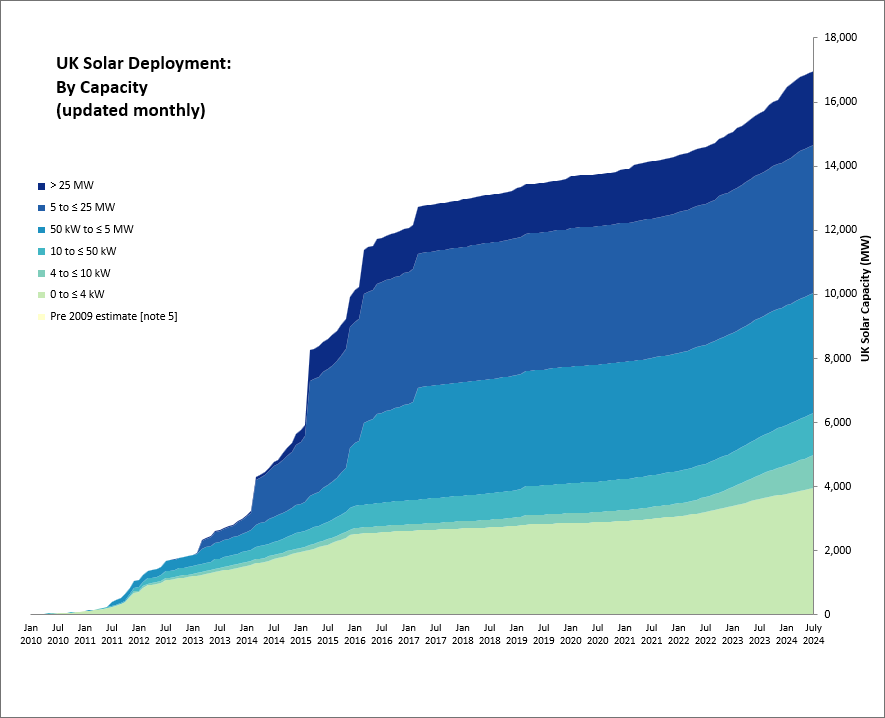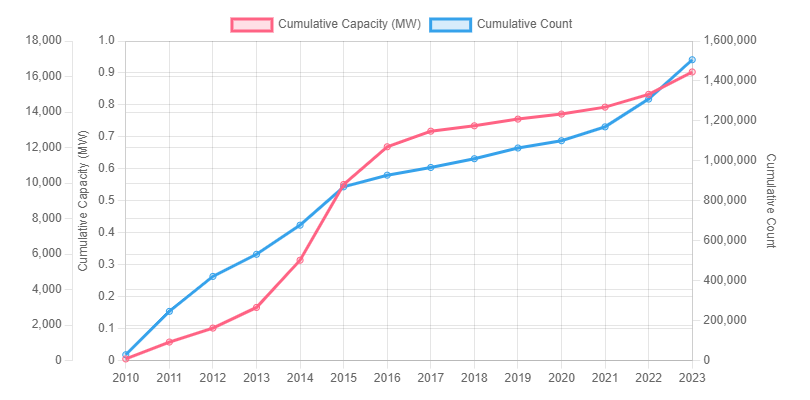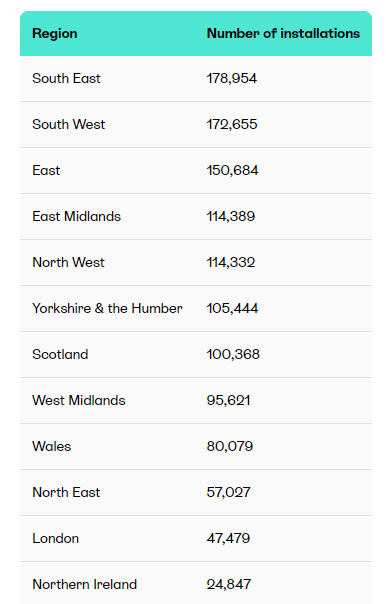Is the UK economy ready to transition into a solar-powered economy?
Solar power has a small yet growing role in electricity production in the UK. Climate change and high energy bills are constantly pushing households and countries to embrace this cheap, renewable source of electricity, resulting in rapid growth.
Solar panels are becoming popular among the current generation for a greener economy and renewable energy source. Their ability to harness the sun’s power is helping UK businesses advance toward a greener and more sustainable future. This article will explore how the UK is gradually transitioning towards a more Solar-Powered economy.
Recent statistics from the Department for Energy and Net Zero (DENZ) reveal that, in August 2024, the UK surpassed its solar photovoltaic capacity by an astonishing 17GW. If you measure that figure in 3kWp solar installations, it’s the equivalent of 5.7 million systems! That is more than an 18,000% increase since 2010 when the UK’s total solar capacity was just 0.0937GW.
This means that, provisionally, as of the end of July 2024, 17.0 GW of solar capacity is installed in the UK across 1,612,381 installations (domestic sites). This is an increase of 7.5% (1.2 GW) since July 2023, which is commendable!
July alone accounted for 16,486 installations and 70 MW of capacity, the highest total seen in 2024. These volumes remain higher than the average figures between 2016 and 2021, subject to revision in future months.
Domestic installations account for 30% of the total capacity compared to commercial installations, which contribute about 70% of the installations.

So, what does all this data mean in layperson's language? What happened in the last 14 years? Did domestic installations increase steadily, or was there a significant boom in solar adoption?
We will use the UK government’s most recent statistics on solar photovoltaics’ deployment, published on August 29th, 20242, to answer these questions. But firstly,
What is solar photovoltaic (Solar PV) capacity?
Solar photovoltaic (PV) capacity refers to the total electricity-generating capacity installed using solar photovoltaic systems.
This is usually measured in MW (megawatts) or GW (gigawatts), and these figures indicate how much solar power can be produced under optimal conditions. Solar panel capacity has drastically grown in the UK since they first began!
The UK government’s stats on solar PV capacity are organised according to ‘cumulative capacity’ and ‘cumulative count.’
What is ‘cumulative’ refer to in this context?
In terms of UK statistics, ‘cumulative’ refers to a total that continuously increases as new data is added to the old data over time. This means it is the total of old and new data.
What is ‘cumulative capacity’?
‘Cumulative capacity’ refers to the total solar panel capacity installed at a specific point in time, including all past installations.
This helps measure the total solar capacity installed to show its growth over a period, which shows the growth in the solar power capacity adoption trend instead of focusing on just one period.
So, how has the UK’s solar capacity drastically grown since 2010?
Both cumulative capacity and installation count have seen significant growth between 2010 and 2024. However, the most rapid capacity growth occurred between 2012 and 2016.
This increase began with introducing the FiT (Feed-in Tariff) scheme from the government to reward solar panel owners for the electricity they generated and extorted through solar. This growth eventually skewed when the government massively cut the amounts paid to Fit recipients, and in 2019, the government stopped the scheme.
The growth rate for both capacity and count slowed down after 2016 but continued to rise gradually. Rising energy bills, constant enthusiasm for greener energy sources, and the introduction of smart export tariffs resulted in a significant uptick in solar panel installations from 2021 onwards.
Below, you can see the growth in megawatts (MW) and installations over time.
Cumulative capacity UK-wide rose from just 93.7MW in 2010 to an impressive 16,973.1 in July 2024—an increase of 16,879.4MW!

Source (https://www.gov.uk/government/organisations/department-for-energy-security-and-net-zero/about/statistics) and (https://www.gov.uk/government/statistics/solar-photovoltaics-deployment)
How does the growth trend for solar PV look in the coming years?
This is a tricky question; many of us would say it looks great. We are progressing towards a greener and sustainable economy. This is true, but predicting what will happen in the future is hard!
This is especially true of the solar industry, which, as a global market, is heavily influenced by developments and innovations worldwide.
According to Ember, solar capacity has increased by an average of 37% per year over the last 22 years, doubling every 2.2 years. In 2023, we hit 413 gigawatts, and if this trend persists, we could easily reach 565 gigawatts in 2024.
This means we should expect to see far more solar panels appearing on the ground, both in solar farms and on newly built homes and other infrastructure. This will be most evident in China, which was responsible for 240 gigawatts over the previous year.
Factors that could impact the growth of solar PV
Global conflicts can sometimes disturb the growth of solar photovoltaics. In 2023, the Russia and Ukraine wars significantly impacted the energy market.
Russia is a major producer of raw materials like nickel and palladium, which are used in producing solar panels and batteries. The Russia-Ukraine conflicts created disruptions in their supply chains, affecting the production and cost of solar products.
This conflict also forced Europe to move away from its reliance on Russian gas, helping to promote investment in solar power. In 2024, if the Russia and Ukraine conflict concludes, this would mean increased production of solar panels—but keeping in mind, Russian trade with Europe recommences. This may also lead to a reduction in the cost of gas, which could affect the prices of solar.
Are there grants and incentives available for solar in the UK?
Yes, it depends on the region you are in. We are working in partnership with West Midlands Combined Authority and Business Growth West Midlands on the 'Decarbonisation Net Zero Programme', which offers SMEs in Black Country grants up to £100K for renewables, compressors, heating and insulation, machine replacement, and more.
We also work with Worcestershire, Marches, Telford, Staffordshire, and Herefordshire grant programmes, which offer solar/renewables as part of their offerings.
To access these grants, you can check us here - https://proenviro.co.uk/grant-funded-programmes/
How many people in the UK want solar panels?
Around two-thirds of adults in the UK are prepared to have solar panels installed. According to the government's 2023 survey, 66% of those who live in owner-occupied homes either have solar panels or will consider installing them in the next few years.
This figure is quite close to the 69% of people who would be ‘likely’ or ‘very likely’ to buy a home with solar panels on the roof, according to a 2023 survey by The Eco Experts.
People demand solar panels, whether on their homes or on local land. In the 2023 government survey, 54% told the researchers they would be happy for a solar panel farm to be constructed in their area—compared to just 8% who would be unhappy.
The proportion of people who want solar panels has stayed stable since at least 2018, when a ClientEarth and YouGov survey found 69% either have or would like to install solar panels at home.
Are you curious to know which region has the most solar panels installed in the UK?
Check out the table here:

How can Pro Enviro help? With over 30+ years of experience in the industry, we are the leaders in dveloping low carbon strategies for businesses of all sizes. If you are a business looking for solar photovoltaics support, please contact our energy experts, we can help you find the right grant programmes for which your business may be eligible. Please get in touch to find out how we can support you.








